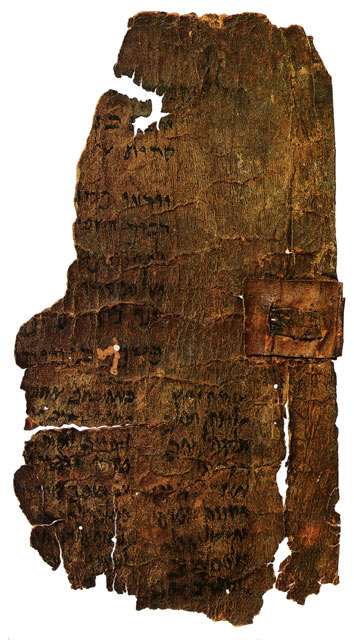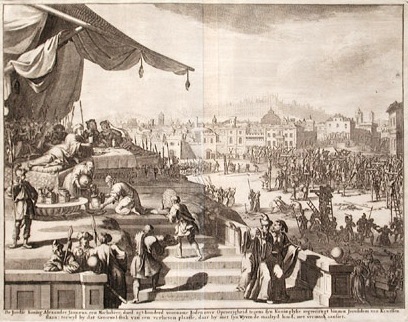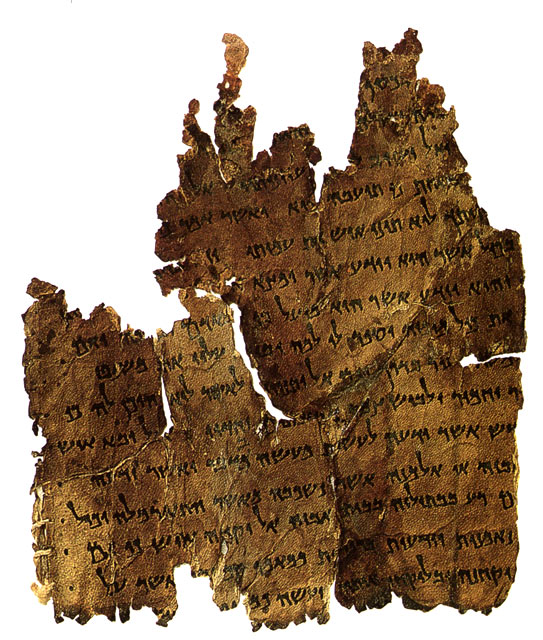|
4Q448
4Q448, often called the "Hymn to King Jonathan," is a piece of parchment from among the Dead Sea Scrolls, found in Cave 4, containing two separate short works, part of Psalm 154 and a prayer mentioning a King Jonathan (''Yəhōnatan''). The only King Jonathan in early Jewish history was Alexander Jannaeus ("Jannaeus" being an abbreviated form of "Jonathan") and it is widely believed that this was the King Jonathan of 4Q448, though some doubt has been raised over the identification. The first column of the prayer may read: ::1 "the holy city, ::2 for Jonathan the king ::3 and all the congregation of your people ::4 Israel ::5 which have been dispersed to the four ::6 winds of the heavens ::7 let peace be on all of them ::8 and your kingdom" ::9 "And may your name be praised" Others translate the first line quite differently: ::"Arise O Holy One"For example, Garcia Martinez, Florentino, and Tigchelaar, Eibert J.C., ''The Dea Sea Scrolls: Study Edition'' Vol. 2 (Leiden: Brill, ... [...More Info...] [...Related Items...] OR: [Wikipedia] [Google] [Baidu] |
4Q448
4Q448, often called the "Hymn to King Jonathan," is a piece of parchment from among the Dead Sea Scrolls, found in Cave 4, containing two separate short works, part of Psalm 154 and a prayer mentioning a King Jonathan (''Yəhōnatan''). The only King Jonathan in early Jewish history was Alexander Jannaeus ("Jannaeus" being an abbreviated form of "Jonathan") and it is widely believed that this was the King Jonathan of 4Q448, though some doubt has been raised over the identification. The first column of the prayer may read: ::1 "the holy city, ::2 for Jonathan the king ::3 and all the congregation of your people ::4 Israel ::5 which have been dispersed to the four ::6 winds of the heavens ::7 let peace be on all of them ::8 and your kingdom" ::9 "And may your name be praised" Others translate the first line quite differently: ::"Arise O Holy One"For example, Garcia Martinez, Florentino, and Tigchelaar, Eibert J.C., ''The Dea Sea Scrolls: Study Edition'' Vol. 2 (Leiden: Brill, ... [...More Info...] [...Related Items...] OR: [Wikipedia] [Google] [Baidu] |
Wicked Priest
Wicked Priest ( he, הכהן הרשע; Romanized Hebrew: ''ha- kōhēn hā-rāš'ā'') is a sobriquet used in the Dead Sea Scrolls '' pesharim'', four times in the Habakkuk Commentary (1QpHab) and once in the Commentary on Psalm 37 (4QpPsa), to refer to an opponent of the "Teacher of Righteousness." It has been suggested that the phrase is a pun on "ha-kōhēn hā-rōš", as meaning "the High Priest", but this is not the proper term for the High Priest. He is generally identified with a Hasmonean (Maccabean) High Priest or Priests. However, his exact identification remains controversial, and has been called "one of the knottiest problems connected with the Dead Sea Scrolls." The most commonly argued-for single candidate is Jonathan Apphus, followed by his brother Simon Thassi; the widespread acceptance of this view, despite its acknowledged weaknesses, has been dubbed the "Jonathan consensus." More recently, some scholars have argued that the sobriquet does not refer to only one ... [...More Info...] [...Related Items...] OR: [Wikipedia] [Google] [Baidu] |
List Of Manuscripts From Qumran Cave 4
The following is a list of the Dead Sea Scrolls from the cave 4 near Qumran. Description Wadi Qumran Cave 4 was discovered in August 1952, and was excavated from 22–29 September 1952 by Gerald Lankester Harding, Roland de Vaux, and Józef Milik.VanderKam, James C., ''The Dead Sea Scrolls Today'', Grand Rapids: Eerdmans, 1994. pp. 10–11. Cave 4 is actually two hand-cut caves (4a and 4b), but since the fragments were mixed, they are labeled as 4Q. Cave 4 is the most famous of Qumran caves both because of its visibility from the Qumran plateau and its productivity. It is visible from the plateau to the south of the Qumran settlement. It is by far the most productive of all Qumran caves, producing ninety percent of the Dead Sea Scrolls and scroll fragments (approx. 15,000 fragments from 500 different texts), including 9–10 copies of Jubilees, along with 21 ''tefillin'' and 7 ''mezuzot''. List of manuscripts Some resources for more complete information on the scrolls are ... [...More Info...] [...Related Items...] OR: [Wikipedia] [Google] [Baidu] |
Dead Sea Scrolls
The Dead Sea Scrolls (also the Qumran Caves Scrolls) are ancient Jewish and Hebrew religious manuscripts discovered between 1946 and 1956 at the Qumran Caves in what was then Mandatory Palestine, near Ein Feshkha in the West Bank, on the northern shore of the Dead Sea. Dating from the 3rd century BCE to the 1st century CE, the Dead Sea Scrolls are considered to be a keystone in the history of archaeology with great historical, religious, and linguistic significance because they include the oldest surviving manuscripts of entire books later included in the biblical canons, along with deuterocanonical and extra-biblical manuscripts which preserve evidence of the diversity of religious thought in late Second Temple Judaism. At the same time they cast new light on the emergence of Christianity and of Rabbinic Judaism. Most of the scrolls are held by Israel in the Shrine of the Book at the Israel Museum, but their ownership is disputed by Jordan due to the Qumran Caves' history: f ... [...More Info...] [...Related Items...] OR: [Wikipedia] [Google] [Baidu] |
Psalms 152–155
Psalms 152 to 155 are additional Psalms found in two Syriac biblical manuscripts to date and several manuscripts of 's "Book of Discipline", first identified by the orientalist librarian Giuseppe Simone Assemani in 1759. Together with Psalm 151 they are also called the Five Apocryphal Psalms of David or the "Five Syriac Psalms". Psalms 152-155 Psalm 152 "Spoken by David when he was contending with the lion and the wolf which took a sheep from his flock."Wright, W. (1887),Some Apocryphal Psalms in Syriac, ''Proceedings of the Society of Biblical Archaeology'', 9, 257–266 This text has survived only in Syriac James H. Charlesworth with James A. Sanders, ''More Psalms of David (Third Century B.C.-First Centiry A.D.). A New Translation and Introduction'', in James H. Charlesworth (1985), ''The Old Testament Pseudoepigrapha'', Garden City, NY: Doubleday & Company Inc., Volume 2, (Vol. 1), (Vol. 2), p. 609 although the original language may have been Hebrew. The text has six vers ... [...More Info...] [...Related Items...] OR: [Wikipedia] [Google] [Baidu] |
Jonathan (name)
Jonathan ( he, , Standard: ''Yəhōnatan''/''Yōnatan'', Tiberian: ''Yо̆hōnāṯān''/''Yōnāṯān'') is a common name given to males which means "YHWH has given" in Hebrew. The earliest known use of the name was in the Bible; one Jonathan was the son of King Saul, a close friend of David. Variants of Jonathan include Jonatan, Djonathan. Biblical variants include Yehonathan, Y'honathan, Yhonathan, Yonathan, Yehonatan, Yonatan, Yonaton, Yonoson, Yeonoson or Yehonasan. In Israel, "Yoni" is a common nickname for ''Yonatan'' (Jonathan) in the same way Jonny is in English. In Latin America both "Jhonny" and "Johnny" coexist due to misspelling and have become commonly used (Jhonny Peralta, Jhonny Rivera, Jhonny da Silva). The name was the 31st-most-popular boys' name in the United States in 2011, according to the SSA.Popular Baby Names< ... [...More Info...] [...Related Items...] OR: [Wikipedia] [Google] [Baidu] |
Alexander Jannaeus
Alexander Jannaeus ( grc-gre, Ἀλέξανδρος Ἰανναῖος ; he, ''Yannaʾy''; born Jonathan ) was the second king of the Hasmonean dynasty, who ruled over an expanding kingdom of Judea from 103 to 76 BCE. A son of John Hyrcanus, he inherited the throne from his brother Aristobulus I, and married his brother's widow, Queen Salome Alexandra. From his conquests to expand the kingdom to a bloody civil war, Alexander's reign has been generalised as cruel and oppressive with never-ending conflict. The major historical sources of Alexander's life are Josephus's '' Antiquities of the Jews'' and ''The Jewish War''. The kingdom of Alexander Jannaeus was the largest and strongest known Jewish State outside of biblical sources, having conquered most of Palestine's Mediterranean coastline and regions surrounding the Jordan River. Alexander also had many of his subjects killed for their disapproval of his handling of state affairs. Due to his territorial expansion and interac ... [...More Info...] [...Related Items...] OR: [Wikipedia] [Google] [Baidu] |
Florentino Garcia Martinez
Florentino is both a masculine given name and a surname. Notable people with the name include: People with the given name *Florentino Alfaro Zamora (died 1871), Costa Rican politician *Florentino Álvarez Mesa (1846–1926), Spanish journalist, writer and politician *Florentino Ameghino (1853–1911), Argentine naturalist, paleontologist, anthropologist and zoologist *Florentino Asensio Barroso (1877–1936), Spanish Roman Catholic bishop *Florentino Ávidos (1870–1956), Brazilian politician *Florentino Bautista (born 1930), Filipino basketball player *Florentino Broce (c. 1943 – 2015), Filipino footballer and manager *Florentino Castro López (born 1949), Mexican politician *Florentino Collantes (1896–1951), Filipino poet *Florentino Das (1918–1964), Filipino sailor *Florentino Domínguez Ordoñez (born 1962), Mexican politician *Florentino Fernández (actor) (born 1972), Spanish actor and comedian *Florentino Fernández (boxer) (1936–2013), Cuban boxer *Florentino Floro ( ... [...More Info...] [...Related Items...] OR: [Wikipedia] [Google] [Baidu] |
Eibert Tigchelaar
Eibert Johannes Calvinus Tigchelaar (born 1959, Sint Anthoniepolder) is a leading authority and author on the subject of the Dead Sea Scrolls. Formerly he held the position of research associate at the Qumran Instituut (Qumran Institute), Rijksuniversiteit Groningen (University of Groningen), was appointed to a professorship at Florida State University, before becoming research professor at Katholieke Universiteit Leuven KU Leuven (or Katholieke Universiteit Leuven) is a Catholic research university in the city of Leuven, Belgium. It conducts teaching, research, and services in computer science, engineering, natural sciences, theology, humanities, medicine, l .... Published books * ''Prophets of Old and the Day of the End: Zechariah, the Book of Watchers and Apocalypti'' (Brill Academic Publishers, 1996) * ''The Dead Sea Scrolls: Study Edition - Vol. 1'' (Brill Academic Publishers, 1997) * ''The Dead Sea Scrolls Study Edition - Vol. 2'' (Brill Academic Publishers, 1998) * ... [...More Info...] [...Related Items...] OR: [Wikipedia] [Google] [Baidu] |
1st-century BC Manuscripts
The 1st century was the century spanning AD 1 ( I) through AD 100 ( C) according to the Julian calendar. It is often written as the or to distinguish it from the 1st century BC (or BCE) which preceded it. The 1st century is considered part of the Classical era, epoch, or historical period. The 1st century also saw the appearance of Christianity. During this period, Europe, North Africa and the Near East fell under increasing domination by the Roman Empire, which continued expanding, most notably conquering Britain under the emperor Claudius ( AD 43). The reforms introduced by Augustus during his long reign stabilized the empire after the turmoil of the previous century's civil wars. Later in the century the Julio-Claudian dynasty, which had been founded by Augustus, came to an end with the suicide of Nero in AD 68. There followed the famous Year of Four Emperors, a brief period of civil war and instability, which was finally brought to an end by Vespasian, ninth Roman em ... [...More Info...] [...Related Items...] OR: [Wikipedia] [Google] [Baidu] |





